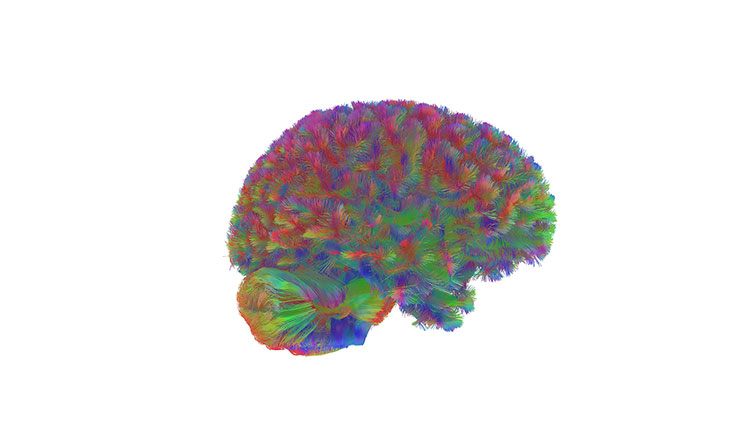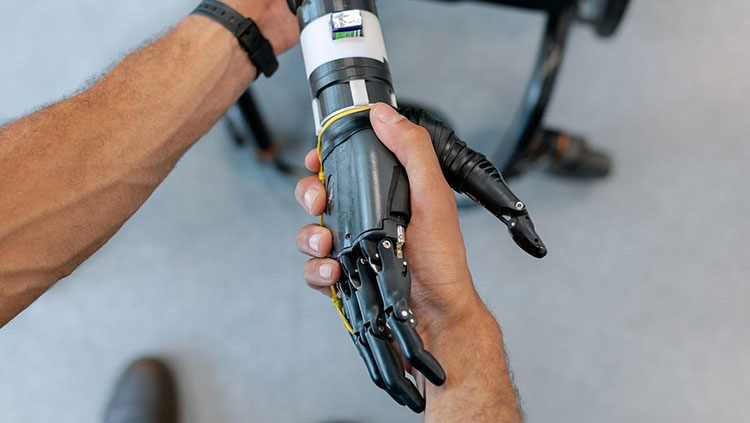ICYMI: Researchers Treated Spinal Muscular Atrophy in Mice Using Base Editing
- Published10 Apr 2023
- Author Christine Won
- Source BrainFacts/SfN

Using a very precise type of gene editing, researchers prevented and even reverted spinal muscular atrophy (SMA) in mice.
SMA is a genetic disorder marked by the progressive degeneration of motor neurons affecting about one in 10,000 in the U.S. The muscle-wasting disease typically occurs when the SMN1 gene, responsible for producing the survival motor neuron (SMN) protein necessary for everyday motor neuron function, is missing or mutated.
In the proof-of-principle study published March 30 in Science, scientists deployed base editing to make a change in a single base pair of the SMN2 gene, a close relative of the SMN1 gene that is present in all patients with SMA, restoring normal production of SMN. Moreover, it prevented further neural degeneration in a mouse model of SMA and led to regeneration and better motor function.
A combination therapy of base editing and nusinersen, an FDA-approved SMA drug, showed the most efficacy.
Big Picture: The findings suggest base editing may improve existing drugs’ performance and offer a potential one-time combination treatment for SMA.
Read More: David Liu’s lab shows new base editing SMA therapy could lead to a one-time therapy. Fierce Biotech
More Top Stories
- Bumblebees are learning how to solve puzzles from each other, hinting at insects' possible culture. A study showed bees that learned to push a colored tab to access sugar water would teach others in their colonies to do the same. While previous research has indicated chimps and birds exhibit signs of culture, or learning from each other, it has not been widely studied in invertebrates. NPR
- Researchers from Osaka University in Japan developed an artificial intelligence that was able to generate images directly from brain signals with 80% accuracy, though the study only involved four people. Interestingly, researchers said such mind-reading AIs work better on certain people. New Scientist
- A study in mice identified a small group of neurons in the glossopharyngeal nerve connecting the throat and the brain that is essential for alerting the brain to the presence of influenza. This triggers the brain to order a systemic response to the infection, such as decreased hunger, thirst, and movement. Nature
- While time perception has long been associated with the brain, a new study reveals the heart may also have a key role. Psychologists at Cornell University outfitted undergraduates with electrocardiograms to measure their heartbeat interval and then asked them to guess how long an audio tune was. Those with a longer interval tended to perceive the audio tone as longer than those with shorter heartbeat intervals who perceived it to be shorter. New York Times
- Researchers grew about 80,000 neurons from mouse brain stem cells and reprogrammed them to build a "living" computer that was able to recognize simple patterns of electricity and light. Eventually, a similar method may even be used to build a robot with living muscle tissues. New Scientist
- A new study revealed exactly how the psychedelic dimenthyltryptamine (DMT) changes brain activity to shed light on the mechanics behind psychedelics' hallucinogenic effects. For the study, researchers analyzed the brain activity of 20 healthy volunteers who received a high-dose injection of DMT (20 mg) using fMRI and electroencephalography (EEG). They observed significant changes in brain activity during the 20-minute trip, particularly in regions associated with high-level cognitive function such as imagination. Technology Networks
- Drunk mice that received a shot of FGF21, a naturally occurring hormone, sobered up twice as fast as those that did not get the hormone shot. Previous research has shown that when alcohol enters the bloodstream, the liver boosts its production of the hormone. The new finding may help shape potential treatments for alcohol poisoning. Science News
- Fish may be able to tell when another fish is afraid and then feel fear themselves — which is regulated by oxytocin, often called the “love hormone” for its ties to social behavior or response like nurturing or empathy. Zebrafish with oxytocin-related genes deleted from their brains were antisocial, unable to sense other fish's anxiety or adapt their behavior accordingly. However, injecting oxytocin into these altered zebrafish restored their capacity for emotional contagion, the ability to detect and mirror others' feelings. AP
- Researchers manipulated the bacterium Photorhabdus asymbiotica's molecular spikes, used to penetrate host cells' membranes, engineering its syringe system to recognize human and mouse cells. Then they loaded the syringes with proteins, such as toxins that can kill cancer cells, to deliver them into mice brains and human cells grown in a lab. This technique may aid drug delivery for hard-to-access systems like the brain or kidneys. Nature
CONTENT PROVIDED BY
BrainFacts/SfN
What to Read Next
Also In Neuroscience in the News
Trending
Popular articles on BrainFacts.org









.jpg)









